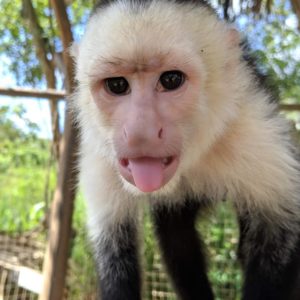Monkeys: White-faced Capuchins
Characteristics, Housing, Diet and other information

Characteristics
White-faced capuchins have distinctive markings that distinguish them from other capuchin monkeys. They have a black body with a white upper chest and shoulders, and a white face with a black cap on top of their head which is said to give these monkeys their name as it resembles the hood of capuchin.
The capuchin is considered to be the most intelligent New World monkey.
It is a long-lived monkey, with a maximum recorded age of over 54 years. Panamanian white-faced capuchins are highly social, living in groups of 16 individuals on average, about three quarters of which are females.
These monkeys are omnivores, so they eat both meat and plants. They eat nuts and fruits such as figs and mangoes. Leaves, insects, lizards, and birds are also on the menu.
Housing
The white-faced capuchin is found in much of Central America. In Central America, its range includes much of Honduras, Nicaragua, Costa Rica and Panama. It has also been reported to occur in eastern Guatemala and southern Belize, but these reports are unconfirmed. It is among the most commonly seen monkeys in Central America.
While the white-faced capuchin is very common in Costa Rica and Panama, the monkey has been largely extirpated from Honduras and much of Nicaragua. Many Honduran capuchins were captured and relocated to the island of Roatán, and many Nicaraguan capuchins were captured and relocated to the island of Ometepe. In Nicaragua, wild capuchins may still be easily spotted in regions around Masaya, as well as around Bluefields and other locations around the South Caribbean coast. They are seen, in the wild, daily by visitors who climb one of the volcanoes on Ometepe Island.
It is found in many different types of forest, including mature and secondary forests, and including evergreen and deciduous forests, dry and moist forests, and mangrove and montane forests. However, it appears to prefer primary or advanced secondary forests. Also, higher densities of white-faced capuchins are found in older areas of forest and in areas containing evergreen forest, as well as areas with more water availability during the dry season.
Diet
They are fed three times a day, these monkeys are omnivores, so they eat both meat and plants. They eat nuts and fruits such as figs and mangoes. Leaves, insects, lizards, and birds are also on the menu. In addition, they sometimes eat tree rats such as the Speckled spiny tree-rat.
Scientists have observed that these white-headed monkeys are willing to try to eat a variety of foods – even an unfamiliar fruit or an insect they’ve never seen before. In short, these monkeys will try to eat anything they find in their habitat.
If you would like to contribute with the wellbeing of our animals, you can make a donation to our paypal account: https://www.paypal.com/paypalme/manawakieecopark , every little bit helps.
